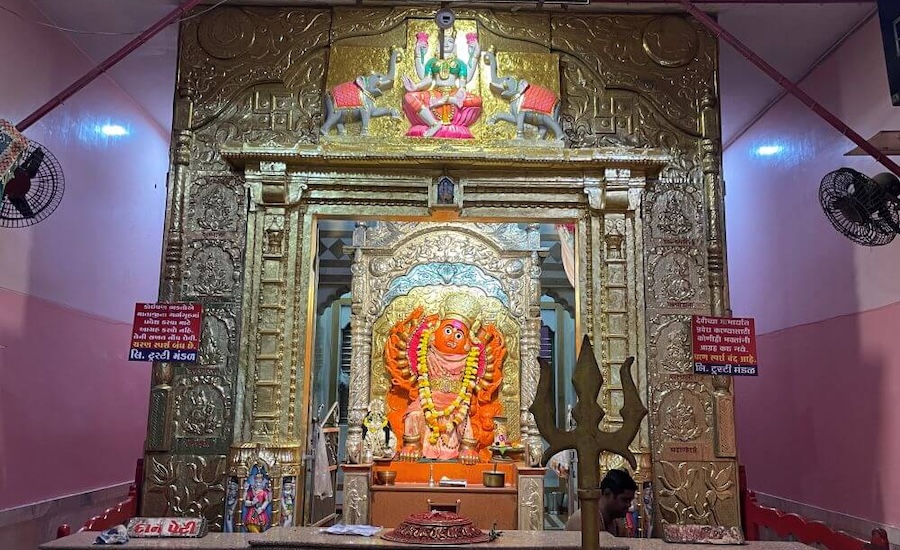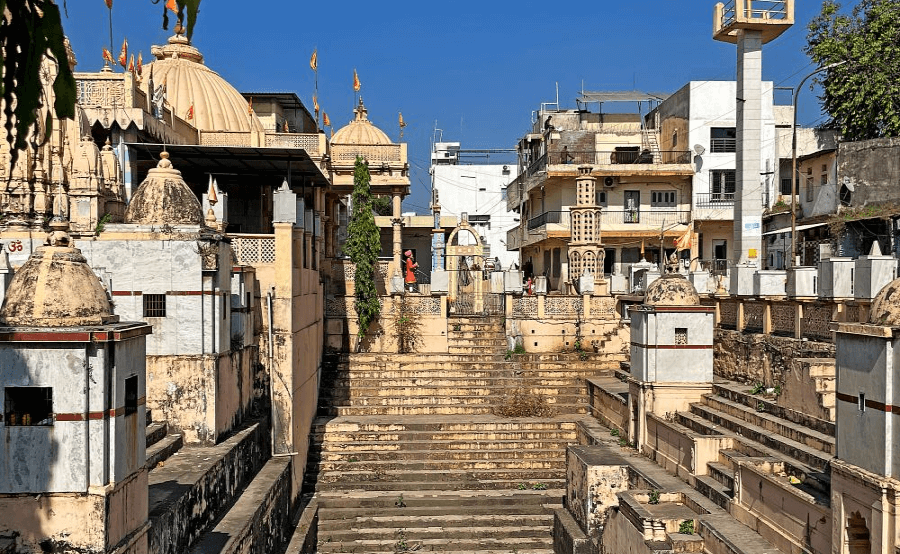
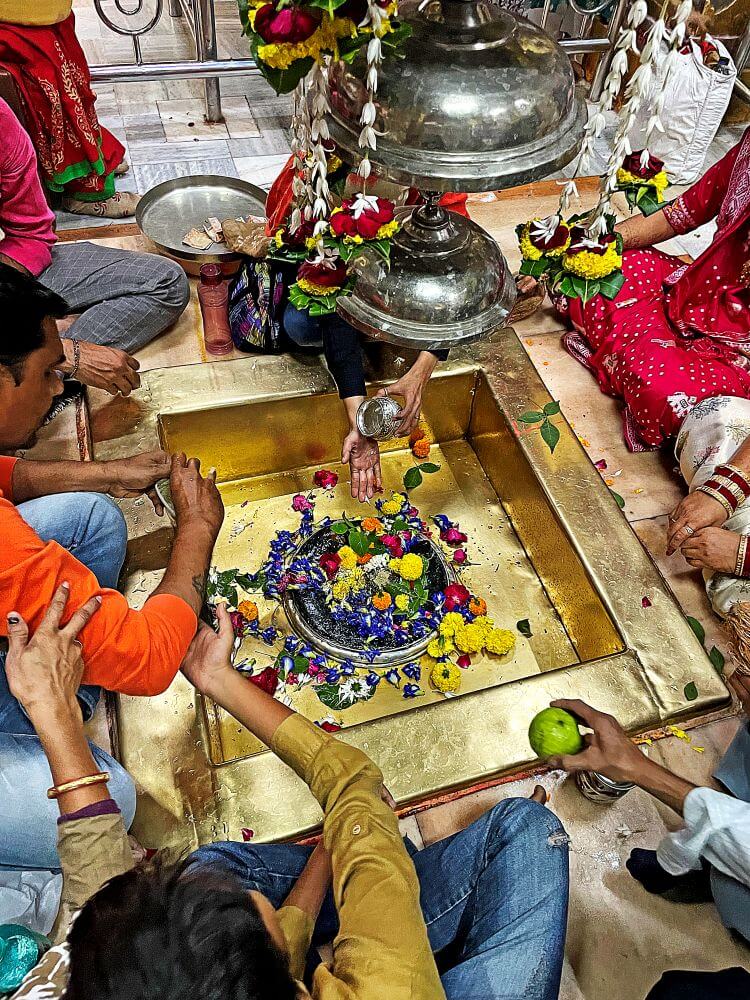 Located in the Katargam Extension of Surat, the Kantareshwar Mahadev Temple is a stunning example of ancient architecture. According to the Puranas, the revered sage Kapil Muni established the Shivling here. The temple also houses the goddess Bhagwati in her Trishakti form, representing the divine trio of strength, knowledge, and prosperity. A unique aspect of the temple is the natural adornment of the Shivling, and the nearby Surya Kund, a sacred water body believed to be created by Lord Rama. It is believed by devotees that drinking the water from this sacred kund (tank) leads to the salvation of one’s ancestors.
Located in the Katargam Extension of Surat, the Kantareshwar Mahadev Temple is a stunning example of ancient architecture. According to the Puranas, the revered sage Kapil Muni established the Shivling here. The temple also houses the goddess Bhagwati in her Trishakti form, representing the divine trio of strength, knowledge, and prosperity. A unique aspect of the temple is the natural adornment of the Shivling, and the nearby Surya Kund, a sacred water body believed to be created by Lord Rama. It is believed by devotees that drinking the water from this sacred kund (tank) leads to the salvation of one’s ancestors.
The temple is steeped in myths and legends. According to the Tapi Purana, Kapil Muni’s ashram once existed at this site. After performing intense penance and donating a cow named Kapila, he appeased the Sun God, who appeared on the Bhadrapada Krishna Shashti day and offered him a boon. Kapil Muni requested the Sun God to reside at his ashram. However, the Sun God warned that his intense energy could destroy the earth. To resolve this, the Sun God invoked Lord Shiva, who absorbed the Sun’s fiery energy into himself. Subsequently, Kapil Muni established the Shivling here, and the deity became known as Suryarupam Mahesh (Shiva in the form of the Sun).
Another legend states that the area was once a dense forest filled with thorny shrubs.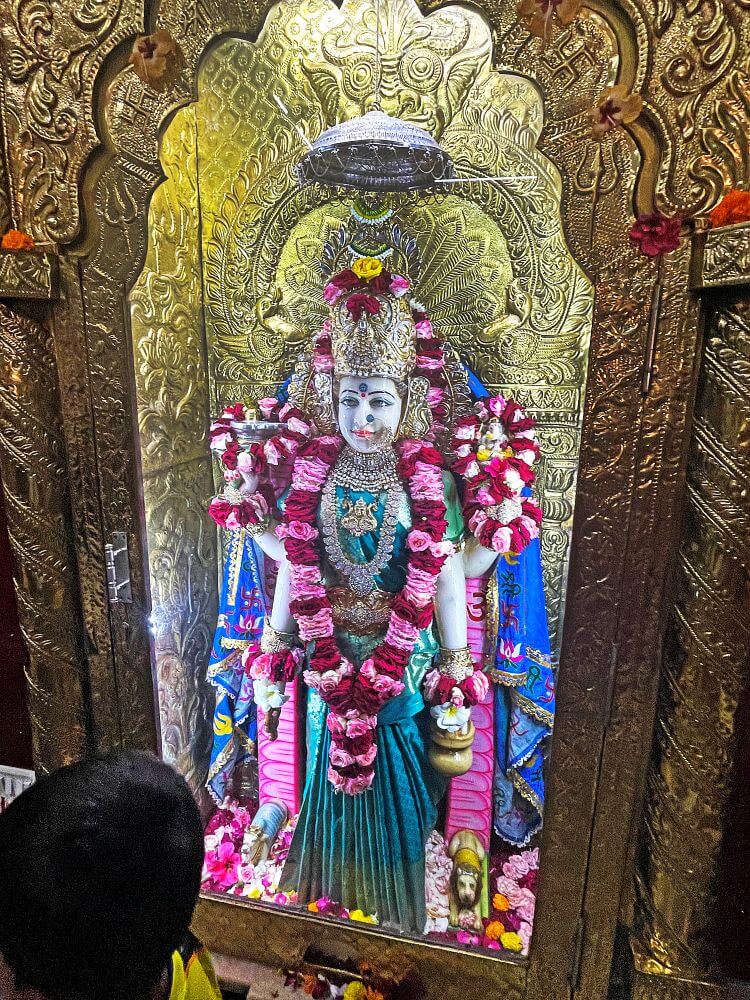 Herdsmen often brought their cattle here. One cow consistently emptied her milk at a specific spot and produced no milk at home. Curious, her owner followed her and discovered the cow releasing milk over a hidden spot in the forest. As he approached, the ground gave way, revealing a divine Shivling. Since the Shivling was found in a thorny forest, it was named Kantareshwar Mahadev (kantar means thorn in Gujarati). The temple is believed to be at least 700 years old, although exact historical evidence is unavailable.
Herdsmen often brought their cattle here. One cow consistently emptied her milk at a specific spot and produced no milk at home. Curious, her owner followed her and discovered the cow releasing milk over a hidden spot in the forest. As he approached, the ground gave way, revealing a divine Shivling. Since the Shivling was found in a thorny forest, it was named Kantareshwar Mahadev (kantar means thorn in Gujarati). The temple is believed to be at least 700 years old, although exact historical evidence is unavailable.
The region is home to five Shiva temples, all beginning with the letter ‘K’: Kantareshwar (Surat), Kedarnath (Badoli), Kadambeshwar (Balpur), Kankeshwar (Kanav), and Kapileshwar (Navsari). Devotees believe that these temples represent the five sibling forms of Lord Shiva, who spiritually unite at Kantareshwar Temple during the Shravan month.
The temple, located in Narayan Nagar Society, has a Surya Kund on its left. According to legend, the sacred Surya Kund has its origins tied to the sage Kapil Muni, who worshipped Lord Vishnu alongside other sages at this site. During their exile, Lord Rama and Lakshmana visited the area. Kapil Muni explained their struggle with water scarcity, which disrupted their spiritual practices, and requested Lord Rama to create a water source for their rituals. In response, Lord Rama shot an arrow into a nearby spot, causing a water stream to emerge. 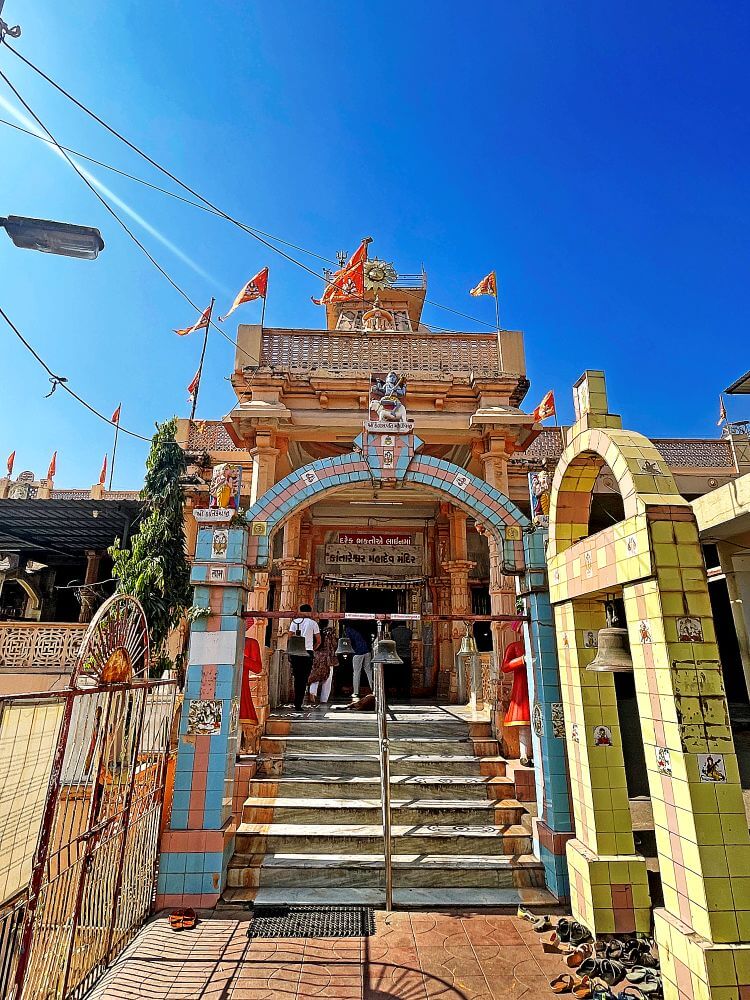 However, since the stream flowed upwards, it was deemed unsuitable for worship. Upon Kapil Muni’s further request, Lord Rama uprooted a nearby stone, forming a tank that could hold water. The tank, which receives the first rays of the sun every day, came to be known as the ‘Surya Kund’ (Sun Tank). Steps were later constructed to facilitate access to the tank.
However, since the stream flowed upwards, it was deemed unsuitable for worship. Upon Kapil Muni’s further request, Lord Rama uprooted a nearby stone, forming a tank that could hold water. The tank, which receives the first rays of the sun every day, came to be known as the ‘Surya Kund’ (Sun Tank). Steps were later constructed to facilitate access to the tank.
Around the top of the Surya Kund, shrines house various deities, sages, and saints. Adjacent to the Kund stands the magnificent temple structure. In front of the temple’s main entrance is a large lamp tower (Deepmala), which is illuminated during festivals, creating a stunning display.
The Nagar-style architecture of Kantareshwar Temple resembles the Kedarnath Temple in Uttarakhand. The temple features intricately carved spires (shikharas) and subsidiary spires (upashikharas), adorned with flags fluttering at their peaks. At the top of the main spire, there is a grand statue of Surya Narayana (the Sun God). The temple features a majestic gateway, where a statue of Lord Shiva mounted on Nandi is prominently displayed. As you ascend the steps to enter the temple, you are greeted by the statues of Dwarapalas (gatekeepers) on either side.
The temple’s architectural design comprises three main sections: the Mukhamandapa (front porch), Sabhamandapa (assembly hall), and Garbhagriha (sanctum sanctorum). 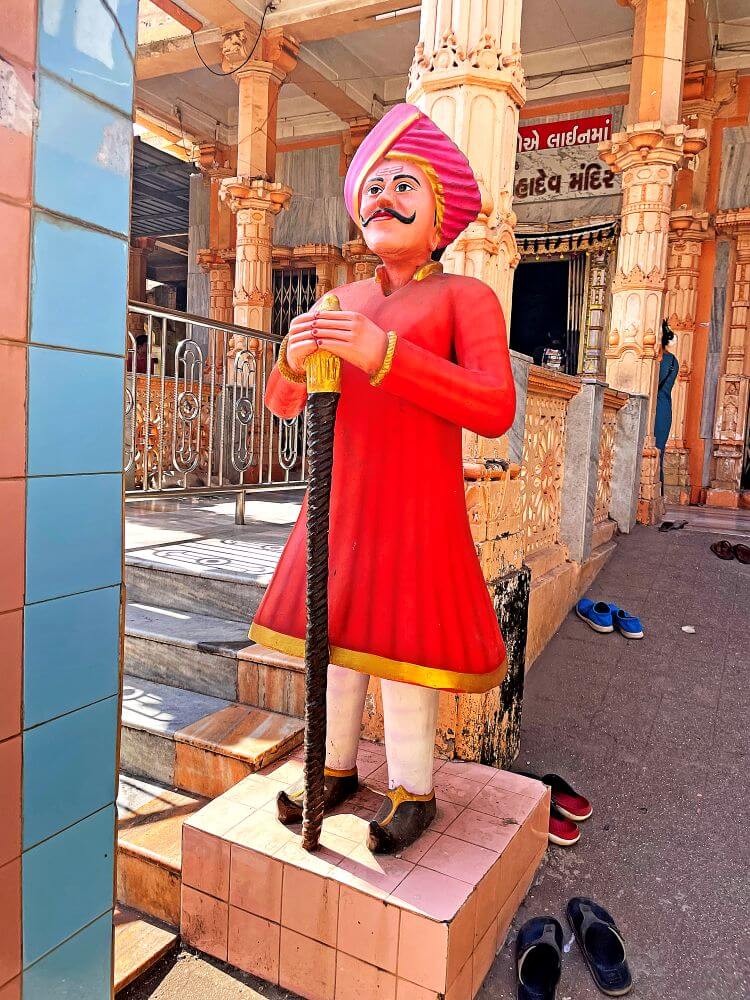 The entrance to the Sabhamandapa is adorned with intricately carved dwarastambhas (pillars) featuring designs of leaves and fruits. One pillar showcases a statue of Kartikeya (the god of war), while the other depicts Gajanana (Lord Ganesha). The mandaraka (threshold) of the entrance is carved with kirtimukhas (a decorative motif symbolising protection) and an ardhachandrashila (a crescent-shaped stone).
The entrance to the Sabhamandapa is adorned with intricately carved dwarastambhas (pillars) featuring designs of leaves and fruits. One pillar showcases a statue of Kartikeya (the god of war), while the other depicts Gajanana (Lord Ganesha). The mandaraka (threshold) of the entrance is carved with kirtimukhas (a decorative motif symbolising protection) and an ardhachandrashila (a crescent-shaped stone).
The Sabhamandapa is spacious and grand, supported by intricately carved pillars. The ceiling is adorned with vibrant paintings, including an image of Surya Narayan (Sun God) riding a chariot drawn by seven horses, as well as depictions of various Shiva Lilas (divine pastimes of Lord Shiva). Along the walls of the Sabhamandapa, small shrines house statues of deities such as Ganesh, Brahma, Surya Narayan, Hanuman, Vishnu, and Kapil Muni.
At the centre of the Sabhamandapa, in front of the Garbhagriha, stands an elevated platform with a large, beautifully sculpted marble Nandi (the sacred bull and vehicle of Lord Shiva). This layout and design create a sanctified and awe-inspiring space for devotees.
The Garbhagriha (sanctum sanctorum) of the temple is notably larger than that of most other Shiva temples. Its door frame is made of stone and features a dual-shafted design. The door pillars are adorned with sculptures of Vaishnav Dwarapalas (gatekeepers of Lord Vishnu). 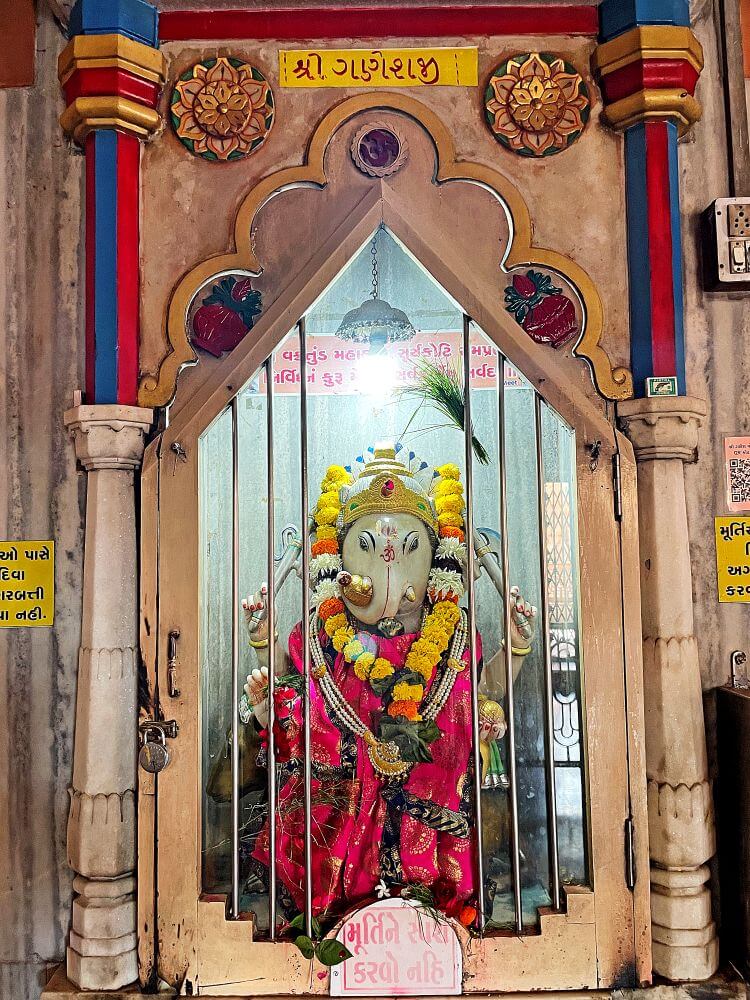 One of these statues holds a bow and displays the Vaishnav Tilak (mark) on its forehead. The mandaraka (threshold) is carved with kirtimukhas (protective motifs) and an ardhachandrashila (crescent-shaped stone), while the lintel panel of the doorway prominently features a beautifully carved statue of Lord Ganesha.
One of these statues holds a bow and displays the Vaishnav Tilak (mark) on its forehead. The mandaraka (threshold) is carved with kirtimukhas (protective motifs) and an ardhachandrashila (crescent-shaped stone), while the lintel panel of the doorway prominently features a beautifully carved statue of Lord Ganesha.
Inside the Garbhagriha, there are broad, intricately carved pillars, each topped with pot-shaped capitals. At the centre of the sanctum lies the sacred Patalalinga, enshrined within a small, square pit adorned with golden plating. The Shivalinga is surrounded by stainless steel railings on all four sides, with mirrors affixed to the pillars of the railings. This arrangement allows devotees standing at a distance to have a clear view of the Shivalinga. Above the Shivalinga is a five-tiered metallic chhatra (umbrella-like canopy). On the wall behind the Shivalinga is an intricately designed golden backdrop (makhara) housing a standing idol of Goddess Parvati, adding a divine and majestic touch to the inner sanctum.
The temple complex also features smaller shrines dedicated to Kuber Bhandari Mahadev and Santoshi Mata. Near the Surya Kund, there are 12 miniature Jyotirlinga temples, offering devotees an opportunity to worship all the Jyotirlingas in one place.
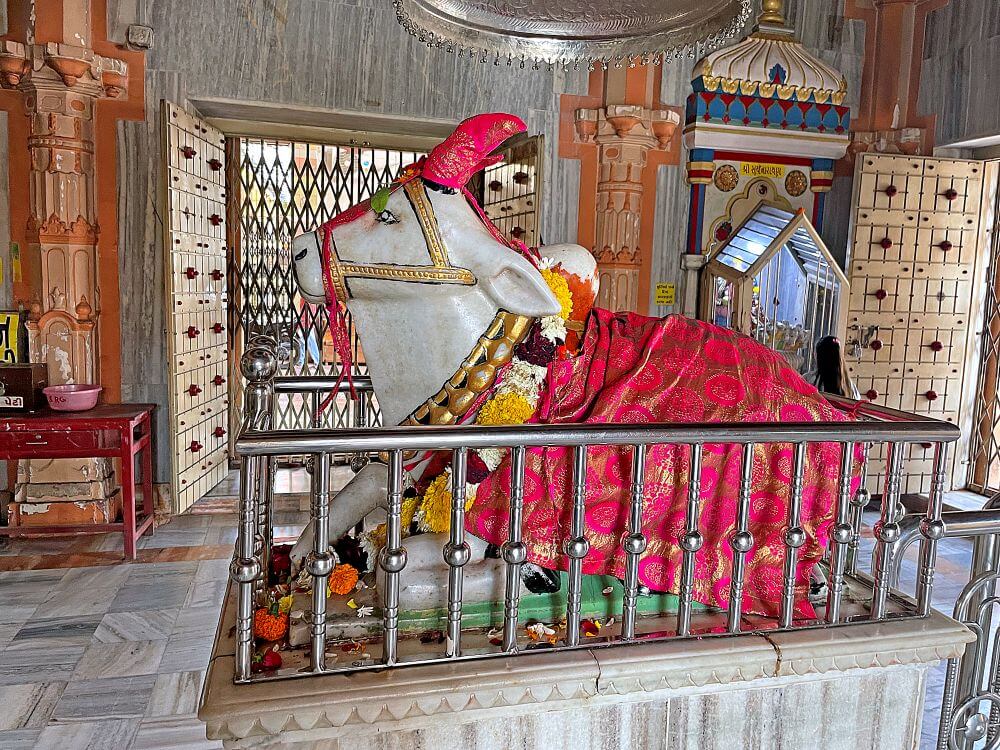 Around 1947, a saint named Nrisimhagiri established a sacred trident (trishul) at the temple. It is believed that the trident’s three points represent the energies of Saraswati, Lakshmi, and Kali. This trident is said to extend 51 feet underground. Although the Shivling and trident are in separate locations, they align perfectly in a straight line, symbolising a spiritual connection. The temple is open for darshan from 5 AM to 8 PM, with extended hours during Mondays, Pradosh days, and Purushottam Maas (Adhik Maas). Worship includes Panchvaktra Puja, a ritual honouring the five faces of Shiva: Sadyojata, Vamadeva, Tatpurusha, Aghora, and Ishana. The Shivling is bathed in Ganga water, anointed with sacred ash, red and yellow sandalwood paste, and adorned with silver leaves, flowers, and betel leaves. A silver Shiva mask completes the decoration, drawing devotees from far and wide.
Around 1947, a saint named Nrisimhagiri established a sacred trident (trishul) at the temple. It is believed that the trident’s three points represent the energies of Saraswati, Lakshmi, and Kali. This trident is said to extend 51 feet underground. Although the Shivling and trident are in separate locations, they align perfectly in a straight line, symbolising a spiritual connection. The temple is open for darshan from 5 AM to 8 PM, with extended hours during Mondays, Pradosh days, and Purushottam Maas (Adhik Maas). Worship includes Panchvaktra Puja, a ritual honouring the five faces of Shiva: Sadyojata, Vamadeva, Tatpurusha, Aghora, and Ishana. The Shivling is bathed in Ganga water, anointed with sacred ash, red and yellow sandalwood paste, and adorned with silver leaves, flowers, and betel leaves. A silver Shiva mask completes the decoration, drawing devotees from far and wide.
Major festivals include Mahashivratri, which features grand processions and a community feast. During Shravan, the temple remains open 24/7 for darshan. Religious discourses, including readings from the Shiv Purana, attract thousands of devotees.
